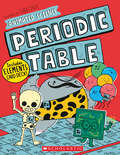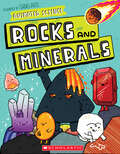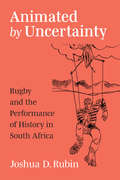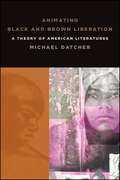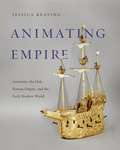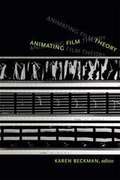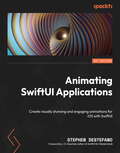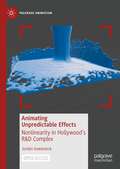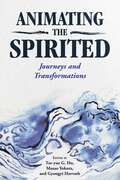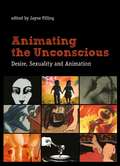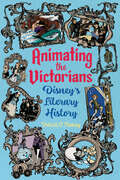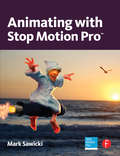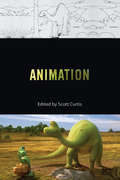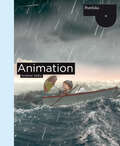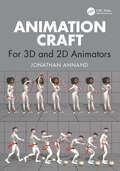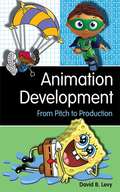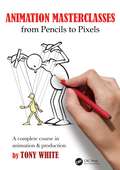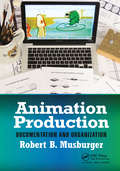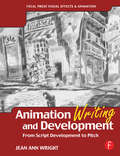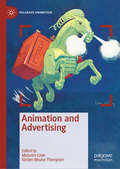- Table View
- List View
Animated Science: Periodic Table
by John FarndonThe elements of the periodic table come alive in the first book in a stellar nonfiction comic series illustrated by Shiho Pate!From oxygen to hydrogen, carbon to plutonium, Animated Science: Periodic Table makes chemistry come alive! In this book you'll meet the building blocks of you, the world, and the universe and see how they come together to make everything you see, do, and use every day.With a narrative nonfiction text, kid-friendly information, and Shiho Pate's engaging illustrations, Animated Science: Periodic Table is a perfect introduction and ready reference, appealing and laugh-out-loud funny. Easily accessible for readers just learning the elements, with more interesting facts and details for older kids honing their knowledge.Great for all ages!
Animated Science: Rocks and Minerals (Animated Science)
by John FarndonRocks and minerals come alive in the next Animated Science book, an outstanding comic series illustrated by Shiho Pate!From gemstones to fossils and beyond, Animated Science: Rocks and Minerals is the definitive guide to rocks and minerals for grade school readers. In this book, readers will explore the substances that make up our Earth through comic illustrations and hilarious characters.With a narrative nonfiction text, kid-friendly information, and Shiho Pate's engaging illustrations, Animated Science: Rocks and Minerals is a perfect introduction and ready reference, appealing and laugh-out-loud funny. Easily accessible for readers just learning, with more interesting facts and details for older kids honing their knowledge.Great for all ages!
Animated by Uncertainty: Rugby and the Performance of History in South Africa (African Perspectives)
by Joshua D RubinIn Animated by Uncertainty, Joshua D. Rubin analyzes South African rugby through the lens of aesthetic politics. Building on 17 months of ethnographic research with rugby coaches, players, and administrators, the author argues that rugby is a form of performance and further that the qualities that define rugby shape the political ends to which the sport can be put. In this respect, Animated by Uncertainty demonstrates that theories of sporting politics cannot afford to overlook the qualities of the sports themselves, and it provides a theoretical approach to illustrate how these qualities can be studied. The book also analyzes the ways that apartheid and colonialism inhere in South African institutions and practices.Drawing inspiration from the observation that South Africans could always abandon rugby if they chose to do so, Rubin highlights how the continuing significance of rugby as a form of performance brings traces of South Africa's apartheid and colonial past into the country's contemporary political moment.
Animating Black and Brown Liberation: A Theory of American Literatures
by Michael DatcherAnimating Black and Brown Liberation introduces a vital new tool for reading American literatures. Rooted in both ancient Egyptian ideas about life and cutting-edge theories of animacy, or levels of aliveness, this tool—ankhing—enables Michael Datcher to examine the ways African American and Latinx literatures respond to and ultimately work to resist hegemonic forces of neoliberalism and state-sponsored oppression. Weaving together close readings and politically informed philosophical reflection, Datcher considers the work of writer-activists Toni Cade Bambara, Cherríe Moraga, Gloria Anzaldúa, June Jordan, Salvador Plascencia, and Ishmael Reed, in light of theoretical interventions by Jane Bennett, Mel Y. Chen, Bruno Latour, Michel Foucault, Paulo Freire, and Erica R. Edwards. How, he asks, can cultural production positively influence Black and Brown material conditions and mobilize collective action "off the page"? How can art-based counterpublics provide a foundation for Black and Brown community organizing? What emerges from Datcher's innovative analysis is a frank assessment of the links between embodied experiences of racialization, as well as a distinctive vision of twentieth- and twenty-first-century American literature as a repository of emancipatory strategies with real-world applications.
Animating Empire: Automata, the Holy Roman Empire, and the Early Modern World
by Jessica KeatingIn the sixteenth and seventeenth centuries, German clockwork automata were collected, displayed, and given as gifts throughout the Holy Roman, Ottoman, and Mughal Empires. In Animating Empire, Jessica Keating recounts the lost history of six such objects and reveals the religious, social, and political meaning they held.The intricate gilt, silver, enameled, and bejeweled clockwork automata, almost exclusively crafted in the city of Augsburg, represented a variety of subjects in motion, from religious figures to animals. Their movements were driven by gears, wheels, and springs painstakingly assembled by clockmakers. Typically wound up and activated by someone in a position of power, these objects and the theological and political arguments they made were highly valued by German-speaking nobility. They were often given as gifts and as tribute payment, and they played remarkable roles in the Holy Roman Empire, particularly with regard to courtly notions about the important early modern issues of universal Christian monarchy, the Reformation, the Counter-Reformation, the encroachment of the Ottoman Empire, and global trade.Demonstrating how automata produced in the Holy Roman Empire spoke to a convergence of historical, religious, and political circumstances, Animating Empire is a fascinating analysis of the animation of inanimate matter in the early modern period. It will appeal especially to art historians and historians of early modern Europe.E-book editions have been made possible through support of the Art History Publication Initiative (AHPI), a collaborative grant from the Andrew W. Mellon Foundation.
Animating Empire: Automata, the Holy Roman Empire, and the Early Modern World
by Jessica KeatingIn the sixteenth and seventeenth centuries, German clockwork automata were collected, displayed, and given as gifts throughout the Holy Roman, Ottoman, and Mughal Empires. In Animating Empire, Jessica Keating recounts the lost history of six such objects and reveals the religious, social, and political meaning they held.The intricate gilt, silver, enameled, and bejeweled clockwork automata, almost exclusively crafted in the city of Augsburg, represented a variety of subjects in motion, from religious figures to animals. Their movements were driven by gears, wheels, and springs painstakingly assembled by clockmakers. Typically wound up and activated by someone in a position of power, these objects and the theological and political arguments they made were highly valued by German-speaking nobility. They were often given as gifts and as tribute payment, and they played remarkable roles in the Holy Roman Empire, particularly with regard to courtly notions about the important early modern issues of universal Christian monarchy, the Reformation, the Counter-Reformation, the encroachment of the Ottoman Empire, and global trade.Demonstrating how automata produced in the Holy Roman Empire spoke to a convergence of historical, religious, and political circumstances, Animating Empire is a fascinating analysis of the animation of inanimate matter in the early modern period. It will appeal especially to art historians and historians of early modern Europe.E-book editions have been made possible through support of the Art History Publication Initiative (AHPI), a collaborative grant from the Andrew W. Mellon Foundation.
Animating Film Theory
by Karen BeckmanAnimating Film Theory provides an enriched understanding of the relationship between two of the most unwieldy and unstable organizing concepts in cinema and media studies: animation and film theory. For the most part, animation has been excluded from the purview of film theory. The contributors to this collection consider the reasons for this marginalization while also bringing attention to key historical contributions across a wide range of animation practices, geographic and linguistic terrains, and historical periods. They delve deep into questions of how animation might best be understood, as well as how it relates to concepts such as the still, the moving image, the frame, animism, and utopia. The contributors take on the kinds of theoretical questions that have remained underexplored because, as Karen Beckman argues, scholars of cinema and media studies have allowed themselves to be constrained by too narrow a sense of what cinema is. This collection reanimates and expands film studies by taking the concept of animation seriously.Contributors. Karen Beckman, Suzanne Buchan, Scott Bukatman, Alan Cholodenko, Yuriko Furuhata, Alexander R. Galloway, Oliver Gaycken, Bishnupriya Ghosh, Tom Gunning, Andrew R. Johnston, Hervé Joubert-Laurencin, Gertrud Koch, Thomas LaMarre, Christopher P. Lehman, Esther Leslie, John MacKay, Mihaela Mihailova, Marc Steinberg, Tess Takahashi
Animating SwiftUI Applications: Create visually stunning and engaging animations for iOS with SwiftUI
by Stephen DeStefano J.D. GauchatUnleash the power of SwiftUI by building dynamic, cross-platform projects that will amaze their usersPurchase of the print or Kindle book includes a free PDF eBookKey FeaturesExplore the basics of declarative programming and animationUnderstand the fundamentals of SwiftUI and animatable propertiesLearn while working on beginner-to-advanced level animation projectsBook DescriptionSwift and SwiftUI are the backbone of Apple application development, making them a crucial skill set to learn. Animating SwiftUI Applications focuses on the creation of stunning animations, making you proficient in this declarative language and employing a minimal code approach.In this book, you'll start by exploring the fundamentals of SwiftUI and animation, before jumping into various projects that will cement these skills in practice. You will explore some simple projects, like animating circles, creating color spectrums with hueRotation, animating individual parts of an image, as well as combining multiple views together to produce dynamic creations. The book will then transition into more advanced animation projects that employ the GeometryReader, which helps align your animations across different devices, as well as creating word and color games. Finally, you will learn how to integrate the SpriteKit framework into our SwiftUI code to create scenes with wind, fire, rain, and or snow scene, along with adding physics, gravity, collisions, and particle emitters to your animations.By the end of this book, you'll have created a number of different animation projects, and will have gained a deep understanding of SwiftUI that can be used for your own creations.What you will learnUnderstand the fundamentals of SwiftUI and declarative programmingMaster animation concepts like state variables and time curvesExplore animation properties like hueRotation, opacity, and scaleCreate animations using physics, gravity, collision, and moreUse the GeometryReader to align views across various platformsCombine different animations for more dynamic effectsAdd audio to your animations for an interactive experienceWho this book is forThis book is for aspiring SwiftUI developers who have a basic understanding of Swift. It can also be used by SwiftUI developers, UIKit developers, and iOS developers that are new to SwiftUI and want to improve their animation proficiency.
Animating Unpredictable Effects: Nonlinearity in Hollywood’s R&D Complex (Palgrave Animation)
by Jordan GowanlockUncanny computer-generated animations of splashing waves, billowing smoke clouds, and characters’ flowing hair have become a ubiquitous presence on screens of all types since the 1980s. This Open Access book charts the history of these digital moving images and the software tools that make them. Unpredictable Visual Effects uncovers an institutional and industrial history that saw media industries conducting more private R&D as Cold War federal funding began to wane in the late 1980s. In this context studios and media software companies took concepts used for studying and managing unpredictable systems like markets, weather, and fluids and turned them into tools for animation. Unpredictable Visual Effects theorizes how these animations are part of a paradigm of control evident across society, while at the same time exploring what they can teach us about the relationship between making and knowing.
Animating the Antique: Sculptural Encounter in the Age of Aesthetic Theory
by Sarah BetzerFramed by tensions between figural sculpture experienced in the round and its translation into two-dimensional representations, Animating the Antique explores enthralling episodes in a history of artistic and aesthetic encounters. Moving across varied locations—among them Rome, Florence, Naples, London, Dresden, and Paris—Sarah Betzer explores a history that has yet to be written: that of the Janus-faced nature of interactions with the antique by which sculptures and beholders alike were caught between the promise of animation and the threat of mortification.Examining the traces of affective and transformative sculptural encounters, the book takes off from the decades marked by the archaeological, art-historical, and art-philosophical developments of the mid-eighteenth century and culminantes in fin de siècle anthropological, psychological, and empathic frameworks. It turns on two fundamental and interconnected arguments: that an eighteenth-century ontology of ancient sculpture continued to inform encounters with the antique well into the nineteenth century, and that by attending to the enduring power of this model, we can newly appreciate the distinctively modern terms of antique sculpture’s allure. As Betzer shows, these eighteenth-century developments had far-reaching ramifications for the making and beholding of modern art, the articulations of art theory, the writing of art history, and a significantly queer Nachleben of the antique.Bold and wide-ranging, Animating the Antique sheds light upon the work of myriad artists, in addition to that of writers ranging from Goethe and Winckelmann to Hegel, Walter Pater, and Vernon Lee. It will be especially welcomed by scholars and students working in eighteenth- and nineteenth-century art history, art writing, and art historiography.
Animating the Spirited: Journeys and Transformations
by Tze-yue G. Hu, Masao Yokota and Gyongyi HorvathContributions by Graham Barton, Raz Greenberg, Gyongyi Horvath, Birgitta Hosea, Tze-yue G. Hu, Yin Ker, M. Javad Khajavi, Richard J. Leskosky, Yuk Lan Ng, Giryung Park, Eileen Anastasia Reynolds, Akiko Sugawa-Shimada, Koji Yamamura, Masao Yokota, and Millie Young Getting in touch with a spiritual side is a craving many are unable to express or voice, but readers and viewers seek out this desired connection to something greater through animation, cinema, anime, and art. Animating the Spirited: Journeys and Transformations includes a range of explorations of the meanings of the spirited and spiritual in the diverse, dynamic, and polarized creative environment of the twenty-first century. While animation is at the heart of the book, such related subjects as fine art, comics, children's literature, folklore, religion, and philosophy enrich the discoveries. These interdisciplinary discussions range from theory to practice, within the framework of an ever-changing media landscape. Working on different continents and coming from varying cultural backgrounds, these diverse scholars, artists, curators, and educators demonstrate the insights of the spirited. Authors also size up new dimensions of mental health and related expressions of human living and interactions. While the book recognizes and acknowledges the particularities of the spirited across cultures, it also highlights its universality, demonstrating how it is being studied, researched, comprehended, expressed, and consumed in various parts of the world.
Animating the Unconscious: Desire, Sexuality and Animation
by Jayne PillingDetailed analysis of both the process and practice of key contemporary filmmakers, while also raising more general issues around the specificities of animation.
Animating the Unconscious: Desire, Sexuality, and Animation
by Ed. Jayne PillingAs critical interest has grown in the unique ways in which art animation explores and depicts subjective experience – particularly in relation to desire, sexuality, social constructions of gender, confessional modes, fantasy, and the animated documentary – this volume offers detailed analysis of both the process and practice of key contemporary filmmakers, while also raising more general issues around the specificities of animation. Combining critical essays with interview material, visual mapping of the creative process, consideration of the neglected issue of how the use of sound differs from that of conventional live-action, and filmmakers' critiques of each others' work, this unique collection aims to both provoke and illuminate via an insightful multi-faceted approach.
Animating the Victorians: Disney's Literary History (Children's Literature Association Series)
by Patrick C. FlemingMany Disney films adapt works from the Victorian period, which is often called the Golden Age of children’s literature. Animating the Victorians: Disney’s Literary History explores Disney’s adaptations of Victorian texts like Alice in Wonderland, Oliver Twist, Treasure Island, Peter Pan, and the tales of Hans Christian Andersen. Author Patrick C. Fleming traces those adaptations from initial concept to theatrical release and beyond to the sequels, consumer products, and theme park attractions that make up a Disney franchise. During the production process, which often extended over decades, Disney’s writers engaged not just with the texts themselves but with the contexts in which they were written, their authors’ biographies, and intervening adaptations. To reveal that process, Fleming draws on preproduction reports, press releases, and unfinished drafts, including materials in the Walt Disney Company Archives, some of which have not yet been discussed in print. But the relationship between Disney and the Victorians goes beyond adaptations. Walt Disney himself had a similar career to the Victorian author-entrepreneur Charles Dickens. Linking the Disney Princess franchise to Victorian ideologies shows how gender and sexuality are constantly being renegotiated. Disney’s animated musicals, theme parks, copyright practices, and even marketing campaigns depend on cultural assumptions, legal frameworks, and media technologies that emerged in nineteenth-century England. Moreover, Disney’s adaptations influence modern students and scholars of the Victorian period. By applying scholarship in Victorian studies to a global company, Fleming shows how institutions mediate our understanding of the past and demonstrates the continued relevance of literary studies in a corporate media age.
Animating with Stop Motion Pro
by Mark SawickiAnimating with Stop Motion Pro is comprehensive, hands-on guide to achieving professional results with Stop Motion Pro 7.0 software. Gone are the days of stop motion guesswork and waiting to see the finalized result of your meticulous, labor intensive animations. With the push of a mouse button and the Stop Motion Pro software, animators have ten times the capability of simple camera stop motion capture. Re-visualize stop motion character movements, graph these movements and composite characters into a flawless animations with the techniques and step by step tutorials featured in Animating with Stop Motion Pro. Detailed exercises allow you to develop professional animations with the included free trial of Stop Motion Pro 7.0.
Animation (Behind the Silver Screen Series)
by Andrew Johnston Susan Ohmer Bob Rehak Kevin Sandler Alla GadassikFrom the earliest motion pictures and cartoons of the 1900s, to the latest 3D animated feature and CGI blockbuster, animation has always been a part of the cinematic experience. While the boundaries between animation and live-action have often been carefully tended, the ubiquity of contemporary computer imaging certainly blurs those lines, thereby confirming the importance of animation for the history of American cinema. The last installment of the acclaimed Behind the Silver Screen series, Animation explores the variety of technologies and modes of production throughout the history of American animation: the artisanal, solitary labors of early animators such as Winsor McCay, or of independent animators such as Mary Ellen Bute; the industrial assembly lines of Hollywood studio-unit animation; the parsimonious production houses of the post-studio, post-war era; the collaborative approach of boutique animation and special-effect houses. Drawing on archival sources, this volume provides not only an overview of American animation history, but also, by focusing on the relationship between production and style, a unique approach to understanding animation in general.
Animation (Portfolio Ser.)
by Andrew SelbyFrom scriptwriting through to production, this introduction to animation for students surveys key technical processes and examines a variety of stylistic approaches. The book includes visual examples from key animators and illustrated features on how to create exciting animation for a variety of audiences.It begins with history and context, and quickly moves on to more practical aspects of the craft. Box features outline practical information and visual examples of different animators’ work and working processes teach how to create exciting animation for any audience. A final chapter on job roles shows how students can get on in animation.This book is a vital resource for anyone who intends to make animation a part of their career.
Animation (Portfolio)
by Andrew SelbyFrom scriptwriting through to production, this introduction to animation for students surveys key technical processes and examines a variety of stylistic approaches. The book includes visual examples from key animators and illustrated features on how to create exciting animation for a variety of audiences.It begins with history and context, and quickly moves on to more practical aspects of the craft. Box features outline practical information and visual examples of different animators’ work and working processes teach how to create exciting animation for any audience. A final chapter on job roles shows how students can get on in animation.This book is a vital resource for anyone who intends to make animation a part of their career.
Animation Behind the Iron Curtain
by Eleanor CowenAnimation Behind the Iron Curtain is a journey of discovery into the world of Soviet era animation from Eastern Bloc countries. From Jerzy Kucia's brutally exquisite Reflections in Poland to the sci-fi adventure of Ott in Space by Estonian puppet master Elbert Tuganov to the endearing Gopo's little man by Ion Popescu-Gopo in Romania, this excursion into Soviet era animation brings to light magnificent art, ruminations on the human condition, and celebrations of innocence and joy.As art reveals the spirit of the times, animation art of Eastern Europe during the Cold War, funded by the Soviet states, allowed artists to create works illuminating to their experiences, hopes, and fears. The political ideology of the time ironically supported these artists while simultaneously suppressing more direct critiques of Soviet life. Politics shaped the world of these artists who then fashioned their realities into amazing works of animation. Their art is integral to the circumstances in which they lived, which is why this book combines the unlikely combination of world politics and animated cartoons.The phenomenal animated films shared in this book offer a glimpse into the culture and hearts of Soviet citizens who grew up with characters as familiar and beloved to them as Mickey Mouse and Bugs Bunny are to Americans. This book lays out the basic political dynamics of the Cold War and how those political tensions affected the animation industry in both the US and in the Eastern Bloc. And, for animation novices and enthusiasts alike, Animation Behind the Iron Curtain also offers breakout sections to explain many of the techniques and aesthetic considerations that go into this fascinating art form. This book is a must read for anyone interested in the Cold War era and really cool animated films!
Animation Craft: For 3D and 2D Animators
by Jonathan AnnandThis book is for those who want to learn the craft or mechanics of animation, how to actually animate a scene from start to finish, or take their animation to the next level. Using over 600 examples, this book answers the questions about the craft of animation that are often not taught in schools or books.Each chapter contains step-by-step examples explaining the principles of animation and how to avoid common problems that occur when animating. This book also teaches you how to critique an animated scene objectively, rather than subjectively — then fix what’s wrong with it.Animation Craft for 3D and 2D Animators will be a great resource for any beginner looking to learn the fundamentals of animation, or more experienced animators looking to hone their craft.
Animation Development: From Pitch to Production
by David B. LevyWhether a novice curious about the cartoon production process, a visual arts student who has not yet experienced that big break, or a seasoned professional looking for valuable insight, Animation Development is the go-to guide for creating the perfect pitch. David Levy has been through every aspect of the pitching process--preparation, hope, rejection, success- and now he wraps up his valuable experience to deliver this comprehensive guide on the industry and process. Animation Development will help readers discover how to tap into their creativity to develop something personal yet universal, push projects through collaborations and partnerships, set up pitch meetings, get legal representation and agents, and manage the emotional roller-coaster common to the pitching and development process.
Animation Masterclasses: A Complete Course in Animation & Production
by Tony WhiteToday, it is commonly believed that if you learn software, you can become an animator. Yet nothing could be further from the truth. Master animators are trained and not born. Software, as is the humble pencil, is merely yet another tool through which an animator can apply their knowledge. However, neither software nor pencils give you that knowledge, nor do they do the work for you. If you place a fully trained master animator on a computer, or give them a pencil, they’ll astound you with their mastery. However, if you put a nontrained animator on a computer, all you will have is a technician creating moving objects ・ as you’ll see all over YouTube and other video platforms. This book teaches you exactly how to become a Master Animator ・ whether you ultimately plan to use pencils, computers, drawing tablets or rigged characters. It’s a complete course in its own right, being a collection of 48 masterclasses gleaned from the author’s 50 years of experience of top-level animating, teaching and filmmaking. It will also train you in the value and application of observational gesture drawing. This book of masterclasses by a master of the art, Tony White, is entirely designed to be THE definitive reference book for students learning how to make things move really well ・ as well as how to create films once you know how to do so. A book for everyone: For home-based, self-study students: It is a perfect manual to take you from raw beginner to proven animated filmmaker. For full-time students: It is an ideal companion to supplement your full-time educational studies, which, no doubt, is overly based on software technology. For current animation professionals: It is a comprehensive archive of animation tips and techniques that will enable you to take your work to the next level. For current animation educators and instructors: It is a book that can be the ultimate curriculum and study program, enabling your own students to become the master animators of today and tomorrow.
Animation Production: Documentation and Organization
by Robert B. MusburgerThis text follows the animation production by concentrating on the documentation necessary to accurately and professionally organize each step of the process. Examples of each piece of paperwork needed to complete the project will be shown. Many newcomers to the field are not experienced in the basic processes to organize their project in an orderly manner. The result is a chaotic, inefficient, and incomplete product. Readers are presented with a step-by-step guide to organizing the process by following professional standards in creating needed and useful documentation for all animators, whether creating in cells, stop-motion, experimental, or computer graphic productions.
Animation Writing and Development: From Script Development to Pitch
by Jean Ann WrightThe art. The craft. The business. Animation Writing and Development takes students and animation professionals alike through the process of creating original characters, developing a television series, feature, or multimedia project, and writing professional premises, outlines and scripts. It covers the process of developing presentation bibles and pitching original projects as well as ideas for episodes of shows already on the air. Animation Writing and Development includes chapters on animation history, on child development (writing for kids), and on storyboarding. It gives advice on marketing and finding work in the industry. It provides exercises for students as well as checklists for professionals polishing their craft. This is a guide to becoming a good writer as well as a successful one.
Animation and Advertising (Palgrave Animation)
by Kirsten Moana Thompson Malcolm CookThroughout its history, animation has been fundamentally shaped by its application to promotion and marketing, with animation playing a vital role in advertising history. In individual case study chapters this book addresses, among others, the role of promotion and advertising for anime, Disney, MTV, Lotte Reiniger, Pixar and George Pal, and highlights American, Indian, Japanese, and European examples. This collection reviews the history of famous animation studios and artists, and rediscovers overlooked ones. It situates animated advertising within the context of a diverse intermedial and multi-platform media environment, influenced by print, radio and digital practices, and expanding beyond cinema and television screens into the workplace, theme park, trade expo and urban environment. It reveals the part that animation has played in shaping our consumption of particular brands and commodities, and assesses the ways in which animated advertising has both changed and been changed by the technologies and media that supported it, including digital production and distribution in the present day. Challenging the traditional privileging of art or entertainment over commercial animation, Animation and Advertising establishes a new and rich field of research, and raises many new questions concerning particular animation and media histories, and our methods for researching them.
